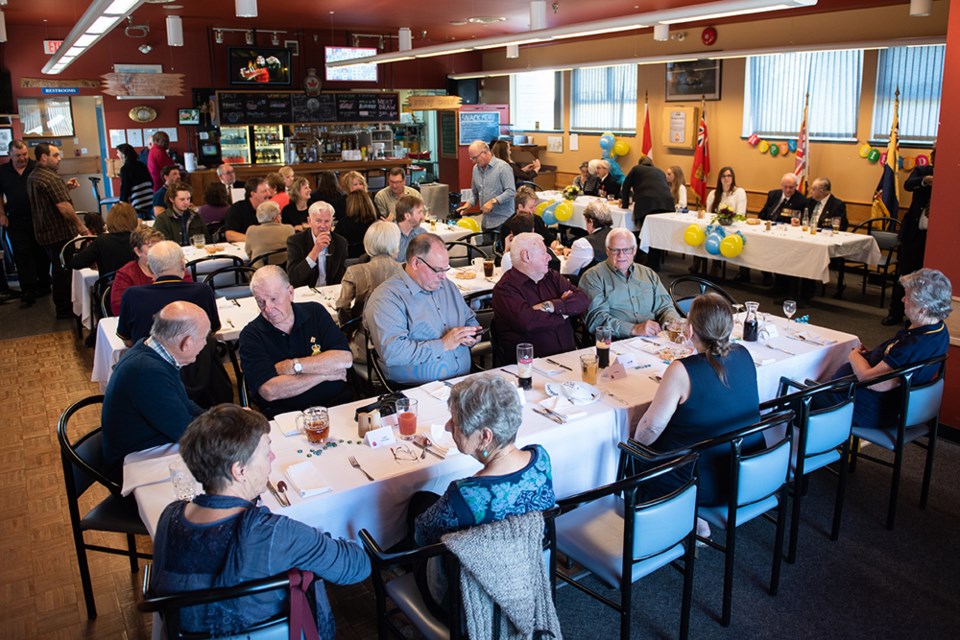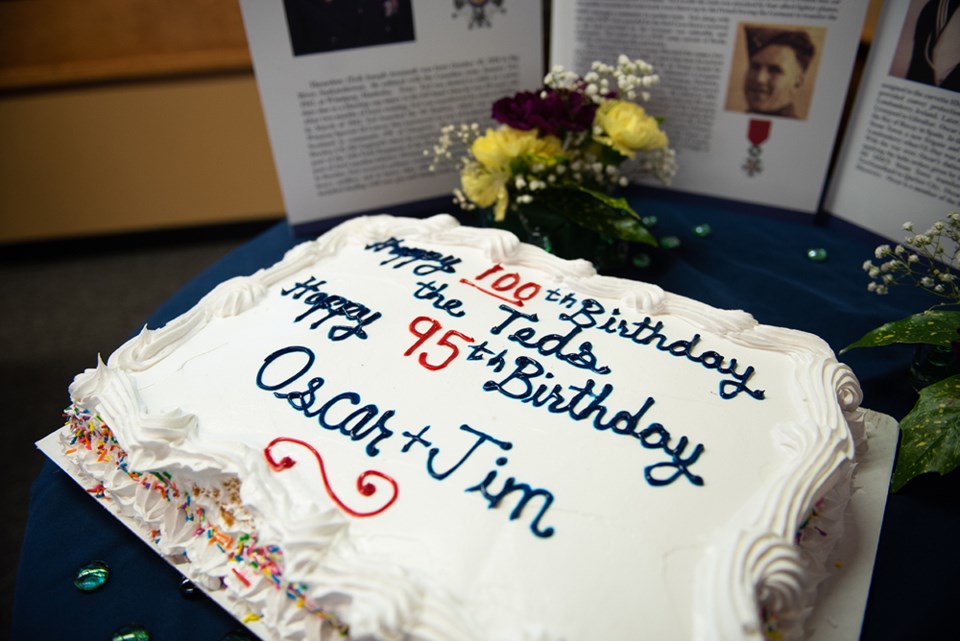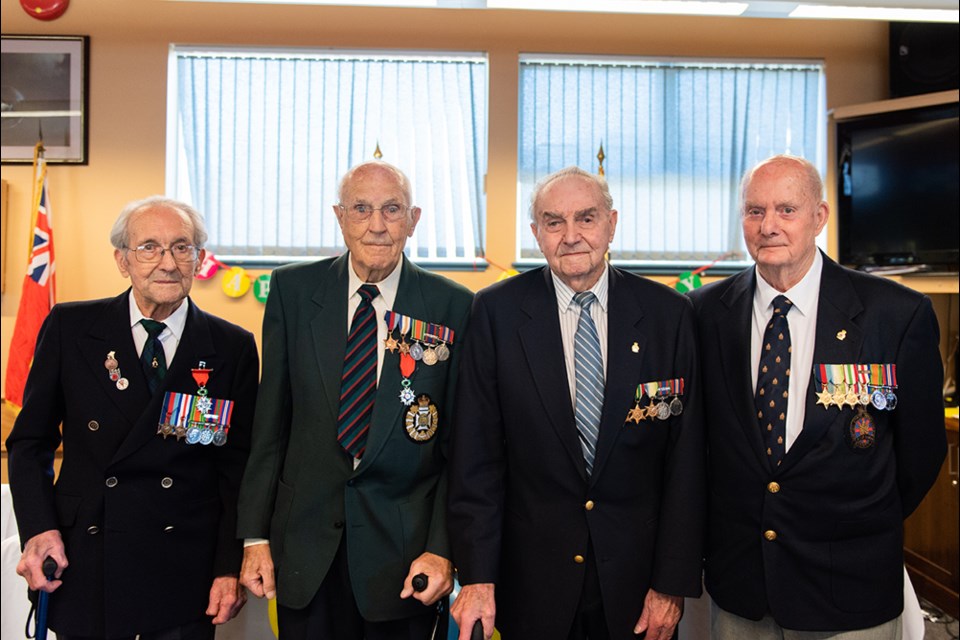The happy birthdays poured in – including two letters from the Queen – at a luncheon for four Squamish veterans celebrating major milestones held last month.
Squamish’s Ted Arsenault and Ted Gregoire turned 100 years old this year, while James Crombie and Oscar Runzer turned 95 years old.
All four served in the Second World War, and were dubbed “The Squamish Four” at a celebration at the Legion Hall complete with cake, bagpipes, and family.
Congratulations were sent by the Governor General, the Prime Minister, Lieut. Gov. of British Columbia, the Premier and MLA Jordan Sturdy. The two centenarians received an acknowledgment from Queen Elizabeth II.
Around 50 people attended the luncheon, including outgoing Mayor Patricia Heintzman.

Stories from the Squamish Four
As part of documenting the stories of veterans in Squamish, as well as across British Columbia and the Yukon, veteran research chairman Ken Ward documented detailed records of the memories of the four men, as well as their service records.
The following short profiles are based on his detailed research and short interviews with the four veterans at the luncheon.
James Crombie — 95 years (birthday July 15)
Born in Kirkcaldy, Scotland, James Crombie had his eyes set on the navy well before the war began. He first tried to join up with the Merchant Navy at 14 — as a cabin boy — but was turned away.
“That was before the war of course, but didn’t get in,” he explained. “I just wanted to go see.”
Crombie would get his chance. When he finally was able to enlist at 17 years old, he recalls, his mother was not impressed.
“I remember my mother comes home and has an envelope and says ‘What’s this? What’s this?’ She says ‘It’s from the government.’ She was quite mad at me because I joined the navy,” he said.
“Nowadays, when a guy joins the navy, he spends at least a year on shore,” explained Crombie. “I had about three weeks, gunnering and all the rest of it.
That was in March of 1941. Crombie soon boarded the Invertay, a minesweeping vessel.
“My first night at sea, believe it or not, we got shot up and bombed,” he said, recalling the sound of explosions. The ship was badly damaged but made it to shore.
“That was my first night at sea,” he said.
The vessel returned to shore for repairs, while Crombie was given leave but would continue on in convoy duty and minesweeping. His vessel was on a decoy mission during the Dieppe Raid in August of 1942, resulting in another treacherous situation where the Interlay collided with another vessel but safely made it to port.
After training as a gun layer in Chatham, England, his service continued in the Atlantic and the Adriatic, including a ship that was part of the D-Day Invasion. After the war ended, Crombie returned home. He was discharged in May of 1946.
“I was very glad [when the war ended], but part of me was sorry too. I enjoyed life in the navy,” he said. “I had itchy feet when I came home, as a bus driver, I wasn’t very satisfied.”
Crombie’s restlessness led him to Canada six years later, to learn a trade. He lived in Ocean Falls and Woodfibre as an engineer before eventually settling in Squamish.
Since then, he has been an active member with the Squamish Legion — with 61 years of service — and is a member of the Black Tusk Caledonia Pipe Band.

Oscar Runzer — 95 years (birthday Sept. 16)
Like Crombie, Runzer and his friends first attempted to join up with the navy before his eighteenth birthday but was turned away. Originally from Romania, his family was living in Abbotsford in the 1930s.
Runzer eventually enlisted and completed his basic training in Vancouver, in March of 1942.
“I can remember a lot of the war — I remember more of it at times than things that happened a week or two ago. It really does get into your mind and stay there,” he said at the luncheon.
“We used to march around Stanley Park, that’s where they did it. We used to march from the warehouse all around, for two months, then we went to Victoria for a couple of months, then boarded ships.”
Onboard the HMCS Prince Robert, Runzer patrolled the west coast of Canada up to Alaska. The year was 1941, just after the Japanese had attacked Pearl Harbour and enemy ships coming across the Pacific were of major concern.
Months later, Runzer took a course on the use of ASDIC, an early form of sonar used to detect submarines. His new training took him across the country — to the East Coast, where sonar operators were in high demand.
On board the HMCS Edmundston, Runzer’s skills were used to provide convoy protection from St. John’s, Newfoundland to Londonderry, Ireland. Later, his ship would provide convoy protection to ships on a route from Liverpool to Gibraltar.
“All the way to the other side of the country, on another ship in Halifax,” he said.
After Victory in Europe Day (VE-Day) and Victory over Japan Day (VJ-Day), Runzer received his discharge in October of 1945 back in Vancouver, at HMCS Discovery. He is a member of the Squamish Legion with over 45 years of service.
Ted Arsenault — 100 years (birthday Oct. 10)
Born in 1918 in Big River, Saskatchewan, Ted Arsenault enlisted with the Canadian Army in 1942 in Winnipeg.
After just two months of basic training, he was transferred to Halifax and made his way across the ocean to Borden in southeast England. In Borden, Arsenault trained in heavy artillery and heavy-duty rifles.
“Ted recalls part of his training included dealing with tear gas and skiing; both unpleasant experiences,” reads his biography in Ward’s Squamish Stories, published in the BC/YUKON Command Military Service Recognition Book.
More unpleasant experiences were to follow. Arsenault participated in several difficult offensives with poor conditions, heavy fighting, and casualties as part of the D-Day force that would liberate France and eventually the rest of Europe.
After fighting their way across Europe, Arsenault and his division arrived in Germany to be part of the V-E Day on May 8th, 1945.
Arsenault didn’t return from the war alone.
He married his Scottish girlfriend, Mary, after they came back to Canada together in 1945. He was then discharged in Regina the following year and became a conservation officer.
Arsenault is a member of the Squamish Legion with over 60 years of service. He is a recipient of the Legion d’Honneur.
Ted Gregoire — 100 years (birthday Nov. 4)
Originally from France, the Gregoire family immigrated to Canada in 1919. Ted Gregoire enlisted with the Royal Winnipeg Rifles shortly after the war began in April of 1940.
Just a few months later, after basic training, he travelled to Halifax by train and then across the ocean to Liverpool, England.
Successfully arriving in Europe, Gregoire spent the next few years preparing for the assault landings on Juno Beach in Normandy. He joined the initial D-Day assault with the Royal Winnipeg Rifles, and survived heavy casualties.
The assault was successful and Gregoire captured three German soldiers — but just two days later, he himself was captured and became a prisoner of war.
He recalled four days of marching followed by detainment at Rennes — very close to his birthplace — before being transported on a French boxcar to Frankfurt. Gregoire would labour in camps outside Berlin, making tiles and bricks, until U.S. forces liberated the camp a few days before V-E Day on May 8 in 1945.
Gregoire is a member of the Squamish Legion with over 50 years of service, and is a recipient of the Legion d’Honneur.



